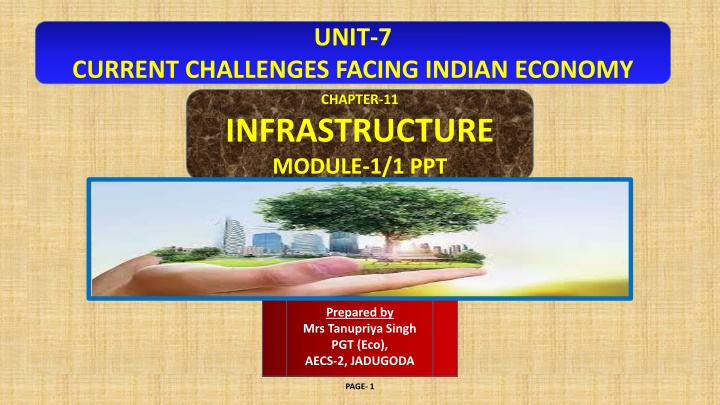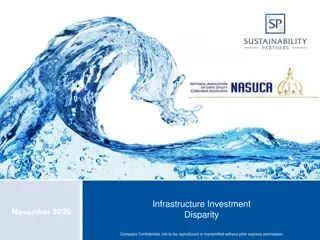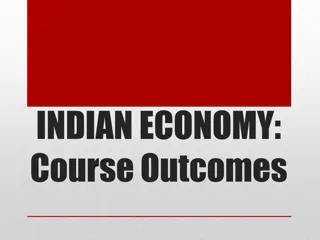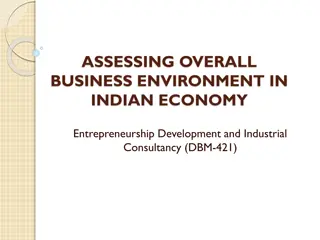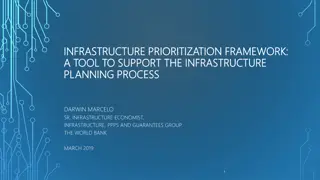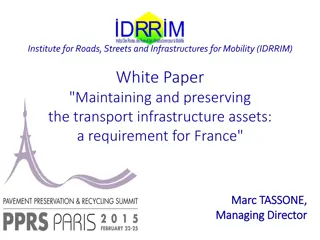Challenges and Importance of Infrastructure in Indian Economy
Infrastructure is crucial for economic growth in India, encompassing services like transport, power, communication, and more. The differing roles of social and economic infrastructure are outlined, highlighting their impact on human and economic resources. The significance of infrastructure lies in its ability to boost productivity, generate employment, attract foreign investments, and spur economic development. However, India's infrastructure investment lags behind other countries, necessitating a focus on areas such as energy, rural development, and sanitation.
Download Presentation

Please find below an Image/Link to download the presentation.
The content on the website is provided AS IS for your information and personal use only. It may not be sold, licensed, or shared on other websites without obtaining consent from the author.If you encounter any issues during the download, it is possible that the publisher has removed the file from their server.
You are allowed to download the files provided on this website for personal or commercial use, subject to the condition that they are used lawfully. All files are the property of their respective owners.
The content on the website is provided AS IS for your information and personal use only. It may not be sold, licensed, or shared on other websites without obtaining consent from the author.
E N D
Presentation Transcript
UNIT-7 CURRENT CHALLENGES FACING INDIAN ECONOMY CHAPTER-11 INFRASTRUCTURE MODULE-1/1 PPT Prepared by Mrs Tanupriya Singh PGT (Eco), AECS-2, JADUGODA PAGE- 1
INFRASTRUCTURE Infrastructure to all such services and facilities, which are needed to provide different kinds of services in an economy and which are essential in raising the place of economic growth of a country. It contributes to economic development of a country both by raising the productivity of factors of production and improving the quality of life of its people. It provides supporting services in the main areas of industrial and agricultural production, domestic and foreign trade and commerce. PAGE- 2
Types of Infrastructure Economic Infrastructure Social Infrastructure a. Transport b. Power c. Communication d. Irrigation and watershed management e. Science and Technology f. Financial Institutions a. Education b. Health c. Housing d. Civic Amenities e. Law and Order etc. PAGE- 3
Difference between Social and Economic Infrastructure Social Infrastructure Economic Infrastructure It helps the economic system from outside(indirectly). It helps the economic system from inside(directly). It improves quality of human resource. It improves the quality of economic resource. For ex- Health, Education and housing For ex- Energy, Transport and communication PAGE- 4
Importance of infrastructure a. Raises productivity b. Provides employment c. Induces foreign investments d. Raises ability to work e. Facilitates outsourcing f. Raises economic development g. Raises size of the market h. Generates linkages in Production PAGE- 5
The state of infrastructure in India India invests approximate 5 percent of its GDP on infrastructure, which is far below than that of china and Indonesia. With government, private sector in partnership with the public sector is also playing a very important role in the infrastructure development. India needs to develop its infrastructure specially in the area of rural energy requirement, water, basic amenities and sanitation. Energy: Energy is the lifeline of all production activities. Rapid growth in agriculture and industrial sector is not possible without it. PAGE- 6
Sources of Energy Commercial sources are coal, petroleum and electricity. Non-commercial sources of energy are firewood agricultural waste and dried dung. Conventional sources of energy include both commercial and noncommercial sources of energy. Example : national gas, coal, petroleum etc. Non-conventional sources of energy are renewable resources of energy like biomass, solar energy, wind energy, tidal energy, etc. PAGE- 7
Power/electricity: The most visible form of energy, which is often identified with progress in modern civilization is power/electricity. Different Sources of Energy Thermal Hydro and Wind Power Nuclear 70% 28% 2% PAGE- 8
Some challenges in the power sector i. Insufficient installed capacity ii. Under Utilisation of capacity iii. Losses incurred by SEBS iv. Uncertain role of private sector v. Public unrest vi. Shortage of raw materials vii. Transmission and distribution losses. viii. Operational inefficiency PAGE- 9
Measures to meet challenges facing the power sector. a. Reduce transmission and distribution losses. b. Improve plant load factor c. Promote the use of CFLs & LEDs to save energy d. Encourage private sector participation e. Encouragement to Non-conventional sources of Energy. f. Bio gas generation programmes. g. Encouragement to FDI and privatisation in Energy production PAGE- 10
Health: Health is not only absence of disease but also the ability to realise one s potential. It is a yardstick of one s well being. Health is the holistic process related to the overall growth and development of the nation. State of health infrastructure: a. There has been significant expansion in physical provision of health services and improvements in health indicators since independence, but it is insufficient for rapidly increasing population in India. b. Public health system and facilities are not sufficient for bulk of the population. PAGE- 11
c. There is a wide gap between rural urban areas and between poor and rich in utilizing health care facilities d. Woman s health across the country has become a matter of great concern with reports of increasing cases of female foeticide and mortality. e. Regulated private sector health services can improve the situation and at the same time, NGOs and community participation is very important in providing health care facilities and reading health awareness. f. Indian system of medicine (ISDM) AYUSH (Ayurveda, yoga and naturopathy unani, siddha, homoeopathy needs to be explored. At the village level, a variety of hospitals known as Primary Health Centers (PHCs) have been set. PAGE- 12
India's Health Infrastructure and Healthcare is made up of a three tier system:- 1. Primary Healthcare 2. Secondary Healthcare 3. Tertiary Healthcare 1. Primary Healthcare:- It includes a) Maternal and child health care b) Promotion of health and provision of essential drugs c) Immunization d)Educating the people about identifying, preventing and controlling diseases. PAGE- 13
2. Secondary Healthcare:- Health care institute having better facilities for surgery, x-ray, ECG are called Secondary Healthcare institutes.Patients are referred here when their condition is not managed by PHC. 3. Tertiary Healthcare:- In this sector, there are the hospitals which have advanced level equipment and medicines and undertake all the complicated health problems. which could not be managed by primary and secondary hospitals. Expansion of health infrastructure has resulted in the eradication of small pox, guinea worms and the near eradication of polio and leprosy. PAGE- 14
Development of health Services in India:- (i) Decline in Death Rate (ii) Rise in expectancy of life (iii) Decline in Infant Mortality Rate (iv) Control over Deadly Diseases. Health as an Emerging Challenge:- (i) Unequal distribution of health care services. (ii) Increasing privatization of health services. (iii) Poor sanitation Level (iv) Poor upkeep and maintenance of govt. health centres and poor management. PAGE- 15
